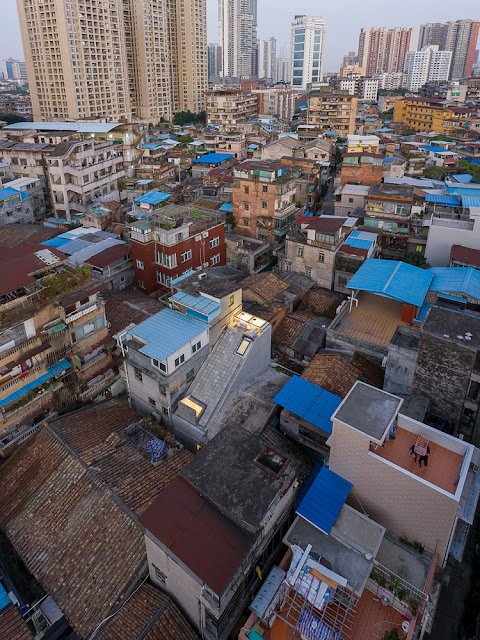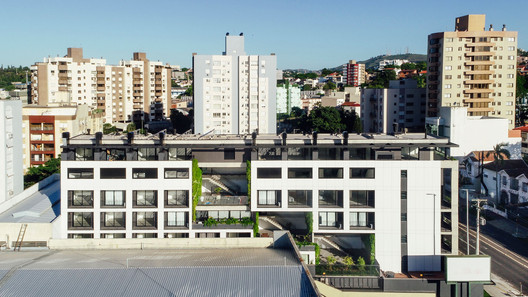- White Paint Can Cool Down Our Heating Cities
- Written by Daniela Porto
The climate has changed, and we have been left grappling with the consequences: high temperatures, flooding, drought and much more. As the world shifts (or tries to shift) to ways to mitigate the crisis, the architecture and construction industry finds itself in a particularly important position whose choices can create real impact. Some of these choices can include innovative products that offer real solutions to complex problems, such as the cooling down of temperatures in highly dense cities.
The United Nations Environment Programme (UNEP) estimates that cities account for 75% of global CO2 emissions, with buildings being one of the biggest culprits. The urban heat island effect occurs when buildings and roads absorb the heat from the sun and emanate this heat throughout the night, contributing to a constant increase in temperatures. In cities with a high concentration of structures and very little greenery or natural landscapes, this effect becomes heightened and can be especially dangerous in humid climates and dense populations. Some of the largest factors also include man-made building materials, urban geometry, human-generated heat and the overall weather and geography.
In increasingly common situations such as the heatwaves in the Pacific Northwest of the United States and Canada, cities can become the hardest hit areas, especially in less affluent and historically marginalized sectors that are densely populated, do not have as much access to cooling systems, and have large swaths of cement without much vegetation to organically cool the air. Considering that more people are estimated to be living in cities in the next decades and that extreme climate events are due to happen more regularly, this prompts the question to architects and designers: How can we design buildings that won’t have this effect on cities?
Enter paint. A number of innovative paint options have cropped up in recent years to mitigate the effects of heat in cities. They mainly capitalize on the benefits of white paint to reflect heat off of buildings and homes and create cooler temperatures that don’t require additional mechanical cooling systems. Although this is yet another palliative solution for an unsustainable way of life in densely populated megacities –which have historically focused on the use of concrete– it is a way to take matters into our own hands, as best we can, while the more complex solutions are underway.
The Coolest White, by UNStudio, is one of these. An “architecture design network”, UNStudio has a variety of units that work on different types of projects, with a focus on the future of the built environment. On a mission to design “humanity-centric experiences to build socially sustainable cities”, the design office created a new paint with a very high total solar reflectance (TSR) coating system that allows for buildings to absorb and radiate less heat than normal, reducing the heat both inside and outside buildings. It also makes for a more resilient coating with less abrasion throughout the years, contributing to less investment in maintenance and additional elements to mitigate the changing climate. The coating system is made with fluoropolymer technology, providing a very protective coating that maintains its gloss and integrity particularly well. In terms of applications, it can be applied to “high-quality metallic façades elements and steel structures made of aluminium, steel, GRP etc. such as industrial and commercial buildings, shopping centers, petrol stations, bridges, overpasses, industrial OEM-coatings, etc.”Another recent launch comes from Purdue University, whose engineering team has been working on a similar alternative. Back in October 2020 they created an ultra-white paint which was recently outdone by their latest creation: a newer, whiter paint that is also more effective at keeping surfaces cool. It reflects up to 98.1% of light and can keep interiors significantly cooler than its surroundings, due to its ultra-whiteness. One of the professors involved calculates that the paint could have a cooling power of up to 10 kilowatts, making it more powerful than most household air conditioners. The technology involved stems from radiative cooling, a passive daytime cooling system that usually involves more complex and multi-layered structures. In this case, the effect is achieved by nanoparticle films and nanocomposite paints that simplify the necessary tools and layers.Other options have also been on the market for a while longer, such as Rain Guard’s Cool Coat, which focuses on “bouncing back” UV rays to prevent too much heat from entering homes. And there is always the option of a simple white paint, which even without any special anti-heat properties, will also contribute to a cooler overall environment; or other environmentally friendly building materials, such as hempcrete or other alternatives to concrete and Climate Tiles.There is no doubt that architecture, design and construction play a large role in the climate crisis. How we move forward will also be in the hands of the professionals who are choosing how to design and construct dwellings, offices and other buildings. Thankfully, the array of eco-conscious products keeps increasing, helping us make better choices for a new world.
ΠΗΓΗ :https://www.archdaily.com/966730/white-paint-can-cool-down-our-heating-citiesutm_medium=email&utm_source=ArchDaily%20List&utm_campaign=product&utm_term=white-buildings&kth=*|KTH|
Το λευκό χρώμα μπορεί να δροσίσει τις θερμές πόλεις μας
Συγγραφέας:Daniela Porto
Το κλίμα έχει αλλάξει και έχουμε μείνει πλεόν να παλεύουμε με τις συνέπειες: υψηλές θερμοκρασίες, πλημμύρες, ξηρασία και πολλά άλλα. Καθώς ο κόσμος στρέφεται (ή προσπαθεί να στραφεί) σε τρόπους μετριασμού της κρίσης, η αρχιτεκτονική και η κατασκευαστική βιομηχανία βρίσκεται σε μια ιδιαίτερα σημαντική θέση, οι επιλογές της οποίας μπορούν να δημιουργήσουν πραγματικό αντίκτυπο. Ορισμένες από αυτές τις επιλογές μπορούν να περιλαμβάνουν καινοτόμα προϊόντα που προσφέρουν πραγματικές λύσεις σε πολύπλοκα προβλήματα, όπως η μείωση των θερμοκρασιών σε πολύ πυκνές πόλεις.
Το Περιβαλλοντικό Πρόγραμμα των Ηνωμένων Εθνών (UNEP) εκτιμά ότι οι πόλεις αντιπροσωπεύουν το 75% των παγκόσμιων εκπομπών CO2, με τα κτίρια να είναι ένας από τους μεγαλύτερους υπαίτιους. Το φαινόμενο της αστικής θερμικής νησίδας εμφανίζεται όταν τα κτίρια και οι δρόμοι απορροφούν τη θερμότητα από τον ήλιο και εκπέμπουν αυτή τη θερμότητα όλη τη νύχτα, συμβάλλοντας σε μια σταθερή αύξηση της θερμοκρασίας. Σε πόλεις με μεγάλη συγκέντρωση δομών και πολύ λίγο πράσινο και πάρκα , αυτό το φαινόμενο γίνεται πιο έντονο και μπορεί να είναι ιδιαίτερα επικίνδυνο σε υγρά κλίματα, πυκνή δόμηση και μεγάλους πληθυσμούς. Μερικοί από τους μεγαλύτερους παράγοντες περιλαμβάνουν επίσης τεχνητά οικοδομικά υλικά, αστική γεωμετρία, θερμότητα που παράγεται από τον άνθρωπινη δραστηριότητα, το κλίμα και τη γεωγραφία.
Μια πρόσφατη μελέτη προέρχεται από το Πανεπιστήμιο Purdue, του οποίου η ομάδα μηχανικής εργάζεται σε μια παρόμοια εναλλακτική λύση. Τον Οκτώβριο του 2020 δημιούργησαν ένα υπερ-λευκό χρώμα το οποίο ξεπέρασε πρόσφατα η τελευταία τους δημιουργία: ένα νεότερο, πιο λευκό χρώμα που είναι επίσης πιο αποτελεσματικό για να διατηρεί τις επιφάνειες δροσερές. Αντανακλά έως και 98,1% του φωτός και μπορεί να διατηρήσει τους εσωτερικούς χώρους σημαντικά πιο δροσερούς από το περιβάλλον του, λόγω της υπερ-λευκότητας του. Ένας από τους εμπλεκόμενους καθηγητές υπολογίζει ότι το χρώμα μπορεί να έχει ψυκτική ισχύ έως και 10 κιλοβάτ, καθιστώντας το πιο ισχυρό από τα περισσότερα οικιακά κλιματιστικά. Η τεχνολογία που εμπλέκεται προέρχεται από την ακτινοβολούμενη ψύξη, ένα παθητικό σύστημα ψύξης κατά τη διάρκεια της ημέρας που συνήθως περιλαμβάνει πιο πολύπλοκες και πολυεπίπεδες δομές. Σε αυτή την περίπτωση, το αποτέλεσμα επιτυγχάνεται με μεμβράνες νανοσωματιδίων και νανοσύνθετα χρώματα που απλοποιούν τα απαραίτητα εργαλεία και στρώματα.
Άλλες επιλογές ήταν επίσης στην αγορά είναι , όπως το Rain Guard's Cool Coat, το οποίο επικεντρώνεται στην "αντανακλαση" των ακτίνων UV για να αποτρέψει την υπερβολική θερμότητα από και στα σπίτια. Και υπάρχει πάντα η επιλογή ενός απλού λευκού χρώματος, το οποίο ακόμη και χωρίς ιδιαίτερες αντιθερμικές ιδιότητες, θα συμβάλει επίσης σε ένα πιο δροσερό συνολικό περιβάλλον ή άλλα οικολογικά οικοδομικά υλικά, όπως ψυχρό σκυρόδεμα ή άλλες εναλλακτικές λύσεις από το σκυρόδεμα και τα ψυχρά πλακίδια .
Δεν υπάρχει αμφιβολία ότι η αρχιτεκτονική, ο σχεδιασμός και η κατασκευή παίζουν μεγάλο ρόλο στην κλιματική κρίση. Το πώς θα προχωρήσουμε θα είναι επίσης στα χέρια των επαγγελματιών που επιλέγουν τον τρόπο σχεδιασμού και κατασκευής κατοικιών, γραφείων και άλλων κτιρίων. Ευτυχώς, η σειρά προϊόντων με την οικολογική συνείδηση να συνεχίζει να αυξάνεται, βοηθώντας μας να κάνουμε καλύτερες επιλογές για έναν νέο κόσμο.
Μεταφραση Κ.Τατσης










